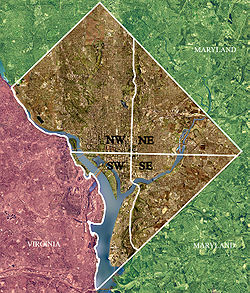Quadrants of Washington, D.C.
This articleneeds additional citations forverification.(August 2016) |

Washington, D.C.,is administratively divided into four geographicalquadrantsof unequal size, each delineated by theirordinal directionsfrom the medallion located in theCrypt under the Rotunda of the Capitol.Street and number addressing, centered on the Capitol, radiates out into each of the quadrants, producing a number of intersections of identically named cross-streets in each quadrant.[clarification needed]Originally, theDistrict of Columbia was a near-perfect squarebut contained more than one settlement; the Capitol was to be the center of the City of Washington. Thus, the Capitol was never located at the geographic center of the whole territory, which was eventually north of the Potomac River, consolidated into one city. (The geographic center was located near the onetime marshy area of the present-day intersection of 17th Street, NW andConstitution Ave.) As a result, the quadrants are of greatly varying size. Northwest is quite large, encompassing over a third of the city's geographical area, while Southwest is little more than a few neighborhoods, large parks, and a military base.
The boundaries of the quadrants are not necessarily straight lines radiating from the medallion, but in three instances follow the paths of the boundary streets (which in some cases curve around topographical features): North Capitol Street, South Capitol Street, and East Capitol Street. The axis of theNational Mallthrough theWashington Monumentand theLincoln Memorialforms the boundary running west of the medallion.
Northwest[edit]
"Northwest"(also written asNWorN.W.) is located north of theNational Malland west of North Capitol Street. It is the largest of the four quadrants of the city, containing more than 42% of the entire city's area[1]and over half of its population.[2]It includes thecentral business district,Federal Triangle,the Smithsonian National Zoo, and the museums along the northern side of the National Mall, as well as such prestigious neighborhoods asFoggy Bottom,West End,Columbia Heights,Petworth,Dupont Circle,Logan Circle,LeDroit Park,Georgetown,Adams Morgan,Embassy Row,Glover Park,Tenleytown,Piney Branch,Shepherd Park,Crestwood,Bloomingdale,andFriendship Heights.The largeRock Creek Parkdivides the northwest quadrant in two.
Northeast[edit]
"Northeast"(NE or N.E.) is located north ofEast Capitol Streetand east ofNorth Capitol Street.Northeast neighborhoods includeBrentwood,Brookland,Ivy City,Marshall Heights,NoMa,Pleasant Hill,Stanton Park,Trinidad,Michigan Park,Riggs Park,Fort Totten,Fort Lincoln,Edgewood,andWoodridge,as well as much ofCapitol Hill.Notable landmarks include theSupreme Court,Union Station,theCatholic University of America,Trinity University,National Shrine of the Immaculate Conception,Franciscan Monastery,Providence Hospital,Gallaudet University,theNational Arboretum,Kenilworth Aquatic Gardens,and theBenning Road Power Plant.
Southeast[edit]
"Southeast"(SE or S.E.) is located south ofEast Capitol Streetand east ofSouth Capitol Street.It has a rich cultural history, including the historicCapitol HillandAnacostianeighborhoods, theNavy Yard,theMarine Barracks,theAnacostia Riverwaterfront, historicEastern Market,the remains of severalCivil War-era forts, historicSt. Elizabeths Hospital,RFK Stadium,Nationals Park,and theCongressional Cemetery.The quadrant is divided by theAnacostia River,with the portion that is west of the river sometimes referred to as "Near Southeast"and the portion east of the river is known as" River East. "Many people mistakenly (or in some instances, pejoratively) call the entire eastern portion of the quadrantAnacostia,although the name refers only to a small area alongMartin Luther King Jr. Avenue.
Southwest[edit]
"Southwest"(SW or S.W.) is located south of theNational Malland west ofSouth Capitol Streetand is the smallest quadrant of the city. Although roughly half of the quadrant is located south of theAnacostia RiverinAnacostia,references to "Southwest" generally allude to the area near downtown, within about a mile of the Capitol, much of which was demolished and redeveloped in the 1960s with modern federal office and apartment buildings. Fort McNair and the National War College are also there. The section south of the river, except for the Bellevue neighborhood, is almost entirely devoted toJoint Base Anacostia-Bolling,theU.S. Naval Research Laboratory,and theBlue Plains Advanced Wastewater Treatment Plant.
See also[edit]
References[edit]
- ^ Adam Froehlig (March 18, 2011)."How much land is in each quadrant?".Greater Greater Washington.RetrievedNovember 27,2016.
- ^DC Office of Planning."DC 2000 Population by Quadrant"(PDF).RetrievedJanuary 9,2020.
